Trying to Conceive
You may remember the stern warning from your high school health teacher that if you are having unprotected sex, you are technically “trying to conceive.”
But many of us have spent so much of our adolescent/adult lives on some form of birth control that by the time we’re actually trying to conceive, we don’t really remember the basics of how things work (guilty) — after all, we’ve spent the past however-many years trying to not get pregnant.
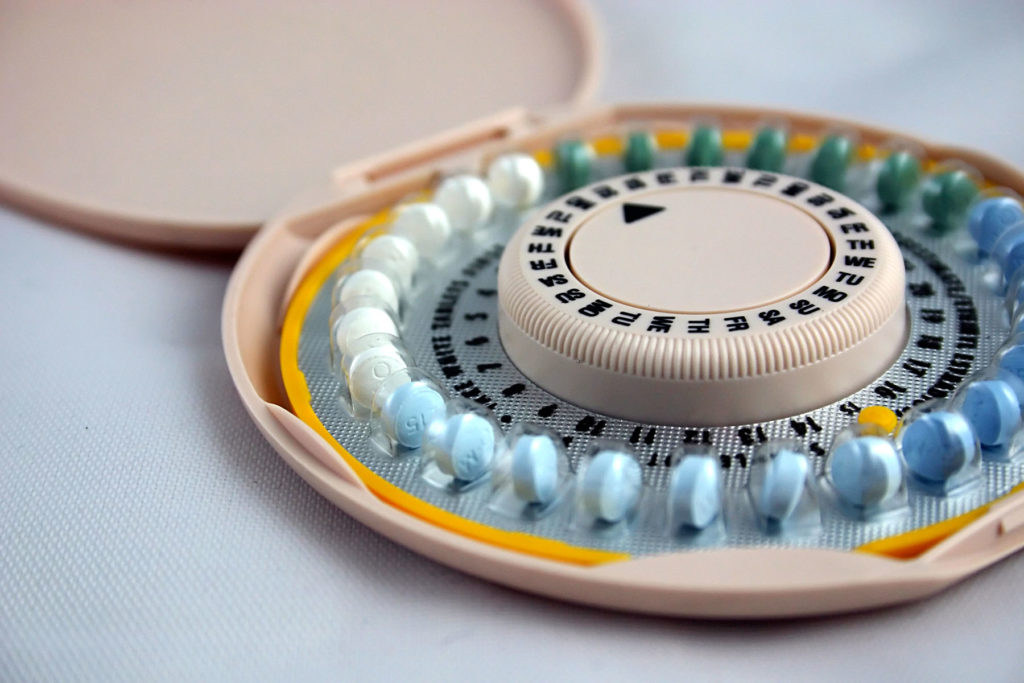
While a lot of women claim that they will simply stop trying not to have a baby and “see what happens,” many women (by the time they finally arrive at this decision), find themselves wanting or expecting to get pregnant right away.
Like, now.
For better or worse, we’ve grown accustomed to making decisions and then acting immediately on them. Making things happen.
But instant gratification doesn’t necessarily apply or happen when you’re trying to conceive.
Once upon a time this exact thing happened to me^^, and I spent an inordinate amount of time researching all things “TTC” (ugh with the acronyms already… just, please no.). I have to say that learning about the basics was hugely reassuring for me. (Confession: I am a grade-A-plan-aheader, so you can make of that what you will…)
If you’re anywhere near this point in your life, here’s what you need to know about basic biology and menstrual cycle tracking, ovulation and the ideal timing of intercourse, and taking a pregnancy test.
*Note: this article is targeted toward heterosexual partners who are trying to conceive. We’re looking forward to expanding this content for LGBTQ+ individuals/families and those seeking to adopt… in the meantime, here are some highly recommended resources for anyone who falls outside the category of “trying to get pregnant the old-fashioned way,” as it were:
- Woven Bodies
- Journey to Same-Sex Parenthood: Firsthand Advice, Tips and Stories from Lesbian and Gay Couples, Eric Rosswood
- The Ultimate Guide to Pregnancy for Lesbians: How to Stay Sane and Care for Yourself from Pre-conception through Birth, Rachel Pepper
- And Baby Makes More: Known Donors, Queer Parents, and Our Unexpected Families, ed. Susan Goldber and Chloe Brushwood Rose
- The Argonauts, Maggie Nelson
- The New Essential Guide to Lesbian Conception, Pregnancy, & Birth, Stephanie Brill
TL:DR
You should get familiar with your menstrual cycle, especially its timing, so that you can try to nail down when you ovulate (that is, release an egg). There is a window of fertility roughly six days right around ovulation (spanning ~5 days before ovulation through 1 day after), but conception is most likely to occur when you time intercourse the day immediately prior to ovulation; thus figuring out the day you ovulate is key.
You can either dig into the nitty-gritty with menstrual cycle tracking, if that floats your boat, or simply aim to have intercourse every other day around the time when you are ovulating.
A Quick Refresher on Menstrual Cycles
Just in case you forgot from your tenth-grade health textbook (or did they call it sex ed where you were??)… and by all means skip ahead and please don’t think I’m belittling anyone if you don’t need the crash course!
First things first: a reorientation to the menstrual cycle…
Even though the “28-day menstrual cycle” is etched into healthcare and clinical practice (and our brains), the truth is that each woman has her own unique cycle — while “28 days” has become the assumption everyone in healthcare works from, it’s just the average. A woman’s cycle can range from a few weeks to five weeks (or more), and everything in between.
Trying to Conceive… After Contraception
Using contraception — regardless of method and duration — does not, broadly speaking, impact a woman’s long-term “fecundability,” aka her ability to conceive.
Women who come off various contraceptive methods and are trying to conceive by and large experience the same pregnancy rates (~80-90%) at one year as anyone else — though, it’s getting harder and harder to conduct this kind of study well, given how many women use contraceptives now.
That said, it’s not at all uncommon for women to experience short- to medium-term delays in returning to fertility, depending on the contraception method you were using:
- Injectable contraceptives ~5-8 cycles
- Patch contraceptives ~4 cycles
- Oral contraceptives and vaginal rings ~3 cycles
- IUDs (hormonal or copper) ~2 cycles
Thus, while many women do begin to ovulate (and even conceive) right away, recent research (such as these results^^) suggests it may take a little time for things to normalize after coming off contraceptives. So keep in mind that if it takes a few months for your cycle to get back on track, that’s totally normal. Your body may need some time to kickstart (and/or routinize) hormonal production on its own, and the timeline for this varies from one woman to the next.
There’s also a longstanding myth that you need to wait a few cycles before becoming pregnant after discontinuing contraception (especially the pill) — but this is indeed a myth.
The idea stems from the mistaken impression that hormones from oral contraceptives lingered in the body (they don’t) and might pose some harm to a fetus — but this is untrue… all the babies born to the small percentage of women who do become pregnant while taking oral contraceptives do not experience any problems. Your body may take some time to return to a normal cycle, but even if it comes back on track right away, it’s completely safe to try for a baby as soon as you like.
Starting with the first day of your last menstrual period (often abbreviated as your “LMP”), roughly the first half of your cycle, however long it is, is the follicular phase. This is basically when your body gets ready to release a mature egg. Ovulation, when the ovaries release a mature egg into the fallopian tubes, often occurs sometime mid-cycle (though the timing is different for every woman) and also kicks off the luteal phase, which is essentially the second half of your cycle. *That last phase isn’t necessarily equivalent in time to the follicular phase.
In the textbook 28-day cycle, menstruation could mark days 1-5, and the follicular phase would lead to ovulation on day 14, followed by a 14-day luteal phase (see above). But these numbers can vary widely — you might have a 34-day cycle where ovulation occurs on day 20/21, with a ~14 day luteal phase. Or a 26-day cycle where ovulation takes place on day 10 or 11, and so on and so forth.
No matter how long your total monthly cycle is, it’s important to get to know it, primarily so you can zero in on ovulation and your “fertile window.” Once released, an egg can only be fertilized for about 12-24 hours (max) — essentially, the egg can either be fertilized and go on to implant into the uterine wall or Pass Go and collect $200 dollars, in which case it is released, along with the outer lining of the uterine wall, through menstruation.
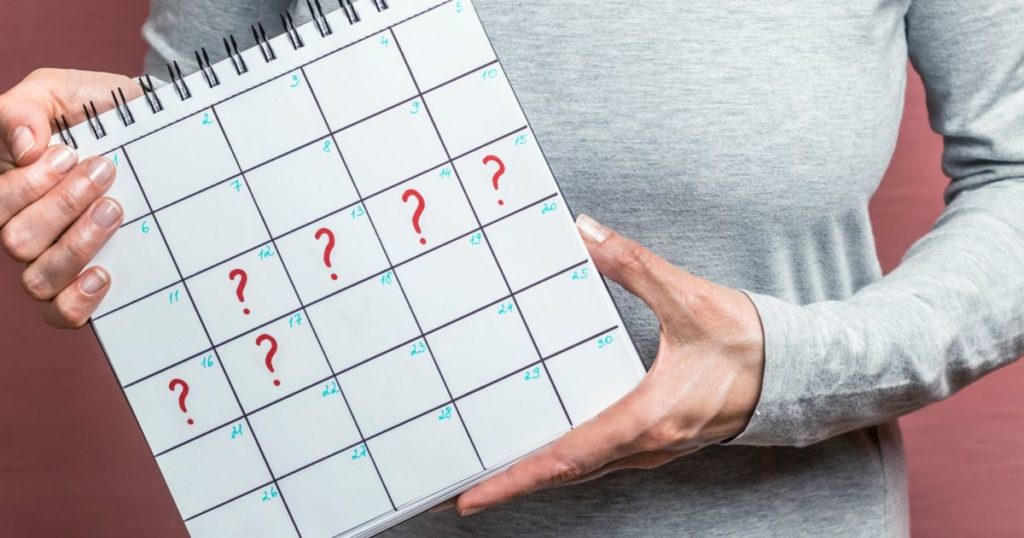
It’s not just ovulation… if you are having trouble getting pregnant, it’s critical to know what’s happening with your cycle. For example, if your luteal phase isn’t long enough (less than 9 days or so), the egg may have difficulty implanting. You would know this is the case by charting your cycle.
I repeat: knowing what’s going on with your menstrual cycle is super important when trying to conceive — if you don’t have a regular cycle (or if you have none at all), you’ll definitely want to talk to your doctor about what to do, because otherwise you are basically shooting in the dark. You are much more likely to meet success if you know when you are ovulating!
This leads us to…
Ovulation and Timing of Intercourse
Once you gain an understanding of your menstrual cycle, and have some idea of when ovulation typically occurs in your cycle, you can begin to get a sense of your fertile window: a roughly six day stretch spanning from five days prior to ovulation to the day immediately after ovulation.
For a long time, the word on the street was that the day you ovulate was the best day to time intercourse, but recent research shows that’s not entirely true. Because it takes time for sperm to make the trip upstream, right before ovulation is the best time: within your fertile window, the couple of days immediately before ovulation are “the sweet spot,” with the day right before ovulation being the best day — this is when the chances of conception are highest. (The goal is to have live sperm in the fallopian tubes during/at ovulation.)
In her book The Impatient Woman’s Guide to Getting Pregnant, Jean Twenge jokes that one option for timing intercourse for conception is the “Lots of Sex Plan” — have sex every other day for the whole middle stretch of your cycle, and you’ll very likely hit one of the aforementioned peak fertile days.
The other option (which sometimes becomes the other option after Lots of Sex grows wearisome) is to learn and know about your cycle such that you can time things accordingly and be reasonably sure you’re having intercourse during your fertile window.
If you’re aiming to time things up with any amount of precision, I repeat: knowing your fertile window is key, and the closer to ovulation you are able to time intercourse, the better. In one study of 221 women, “conception occurred only when intercourse took place during a six-day period that ended on the estimated day of ovulation.” In the same study, the probability of conception was 10% when intercourse occurred five days prior to ovulation and 33% — much higher — when intercourse was timed with ovulation.
According to research from the American Society of Reproductive Medicine, the chances of conception in any given month vary by age:
“Frequent intercourse during ovulation or through the entire month is not necessary for conception and may become taxing on the body and on the relationship.”
Dr. Ricardo Yazigi, Shady Grove Fertility
Other things to know:
- Lube is generally not advised, as it can inhibit sperm’s motility;
- There’s no research showing that sexual position affects your chances of conception;
- Smoking can impact the chances of conception and pregnancy (the chemicals in cigarette smoke speed up the loss rate of eggs, and unfortunately, once eggs die, they cannot regenerate or be replaced);
- There’s no research to this effect, but the advice to lie down or relax for a little while (as opposed to getting up right away) after intercourse makes practical sense;
- You can’t time intercourse to choose the sex of a fetus.
Heads up! Start taking a prenatal vitamin (or a folic acid supplement) now, because folic acid is SUPER important in the very earliest stages of pregnancy.
OK, Then What?
Well… you wait. Maybe you pee on a stick (see below).
Something else to know: This can be emotional.
I know a lot of women who expected to be all “loosy goosy” and relaxed about trying for pregnancy, but once they were “in it” felt incredibly stressed.
Every month presents both a reset button and a new opportunity to take action, but the pattern of things — and the wondering, shit the wondering — can really wear on you. I’m not sure there’s any magic bullet for this. There’s no way to predict what’s going to happen, but just being aware of it and making sure to practice self care, etc. etc. can help mitigate that anxiety up front.
Of 100 couples, some half will conceive within 6/7 months and most of the rest will conceive in the remaining months of the year.
Typically, health professionals will advise families to try for about a year on their own before beginning conversations about possible interventions, however the timing may be shorter for couples over 35.
Taking a Test
Home pregnancy tests (which BTW didn’t exist before the 1970s… science is so cool) work by detecting human chorionic gonadotropin, otherwise known as hCG. Immediately after a fertilized egg implants in the uterine wall, a woman’s body starts to produce hCG — but there won’t be enough of it for a pregnancy test to pick it up for a couple of weeks. (Thus, there’s no point taking a test before then…)
More sensitive tests can detect levels as low as 10-15 mIU/ml, but most are in the 25-50 mIU/ml range. Everyone’s body is different, but generally speaking most women won’t have hCG levels high enough to show up on a home pregnancy test until ~4 weeks out from their last menstrual period (abbreviated as LMP in the chart below — seriously folks, the acronyms in the TTC world are OOC.)
If you want to learn more about the wonderful world of hCG, I wrote a short piece on home pregnancy testing when I was pregnant with my second.
Always take a home test first thing in the morning, as that’s when hCG levels are highest.
The big secret about pregnancy tests is that it doesn’t much matter which kind you take. Many women like the easy-to-read digital readers that simply give you a literal yes or no, such as Clearblue ($15/3) and the First Response classic “second line” test ($12/3), but you could also opt for the low-tech hCG testing strips, which are a little more hands on, shall we say, but are insanely cheap ($12/50). The latter are what doctor’s offices use, so they are no less accurate, but they come with all of zero bells and whistles.
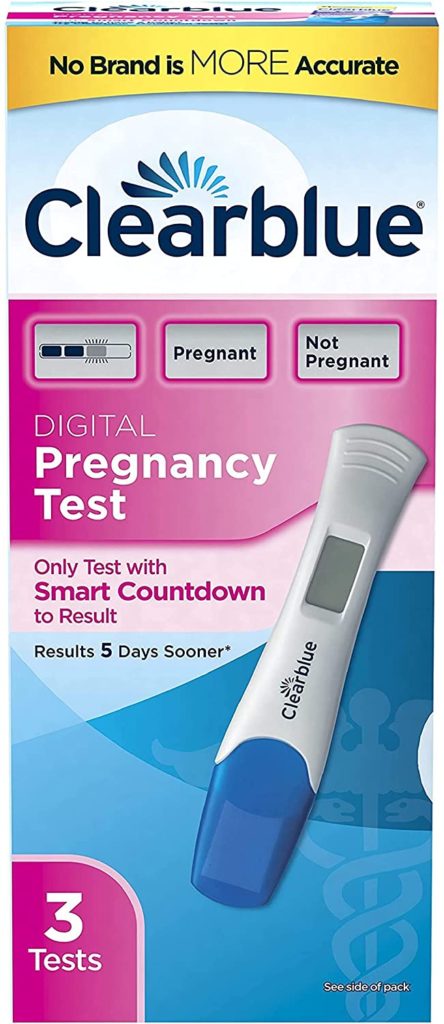
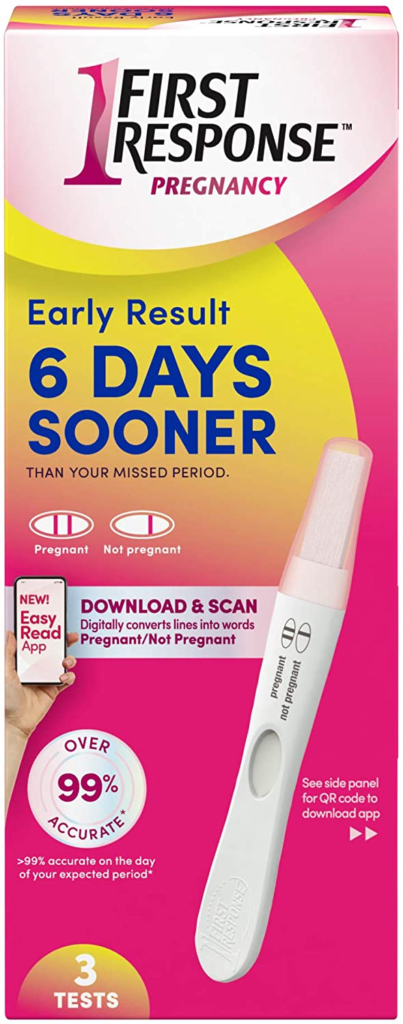
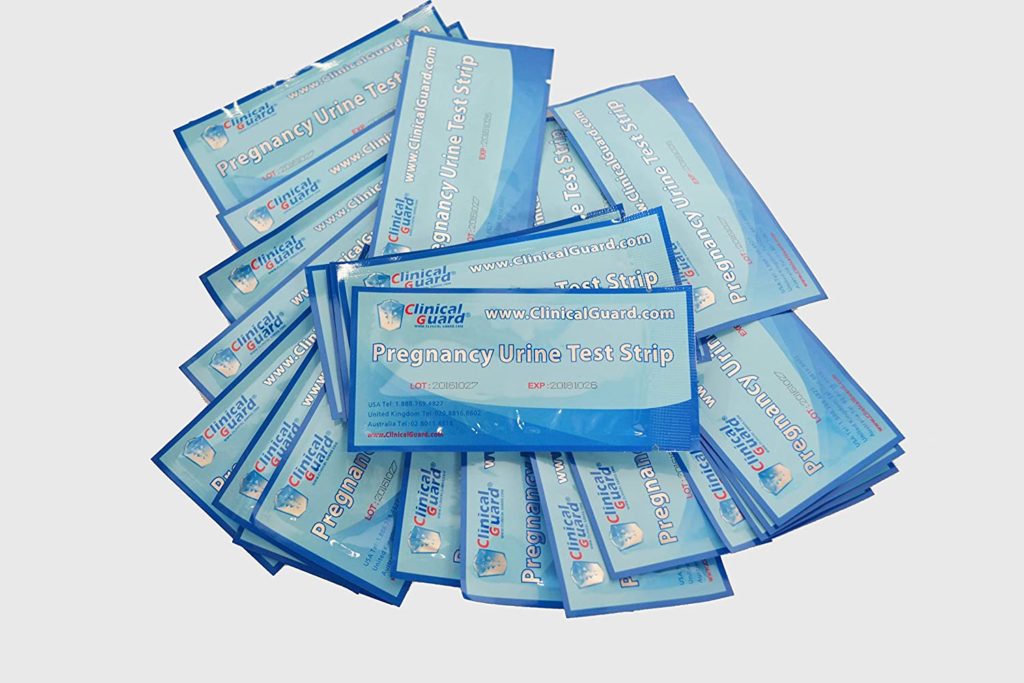
**The two weeks of waiting to take a test and see if you are pregnant can be brutally long — I remember being SO distracted and anxious. There’s no simple recipe for getting through it except to know that time does pass…
In the meantime, check out our trying to conceive book round-up — or, even better, take a peek at some other great books that have nothing at all to do with pregnancy or babies and are sure to be a good diversion. 🙂
This entire experience feels and plays out so differently for everyone — we are wishing you the best (and peace) through your own journey. ❤️